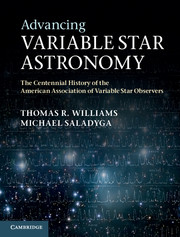 Advancing Variable Star Astronomy
Advancing Variable Star Astronomy Book contents
- Frontmatter
- Contents
- Foreword
- Preface
- Acknowledgments
- PART I PIONEERS IN VARIABLE STAR ASTRONOMY PRIOR TO 1909
- 1 The emergence of variable star astronomy – a need for observations
- 2 A need for observers
- PART II THE FOUNDING OF THE AAVSO – THE WILLIAM TYLER OLCOTT ERA
- PART III RECORDING AND CLASSIFICATION – THE LEON CAMPBELL ERA
- PART IV THE SERVICE BUREAU – THE MARGARET MAYALL ERA
- PART V ANALYSIS AND SCIENCE – THE JANET MATTEI ERA
- PART VI ACCELERATING OBSERVATIONAL SCIENCE – THE ARNE HENDEN ERA
- Appendix A AAVSO historiographic notes
- Appendix B Top AAVSO observer totals
- Appendix C Variable star observing groups represented in the AAVSO International Database
- Appendix D AAVSO Awards
- Appendix E Officers of the AAVSO
- Appendix F AAVSO Council members
- Appendix G AAVSO Scientific committee, section, division, and program chairs
- Notes
- Bibliography
- Index
1 - The emergence of variable star astronomy – a need for observations
from PART I - PIONEERS IN VARIABLE STAR ASTRONOMY PRIOR TO 1909
Published online by Cambridge University Press: 13 June 2011
- Frontmatter
- Contents
- Foreword
- Preface
- Acknowledgments
- PART I PIONEERS IN VARIABLE STAR ASTRONOMY PRIOR TO 1909
- 1 The emergence of variable star astronomy – a need for observations
- 2 A need for observers
- PART II THE FOUNDING OF THE AAVSO – THE WILLIAM TYLER OLCOTT ERA
- PART III RECORDING AND CLASSIFICATION – THE LEON CAMPBELL ERA
- PART IV THE SERVICE BUREAU – THE MARGARET MAYALL ERA
- PART V ANALYSIS AND SCIENCE – THE JANET MATTEI ERA
- PART VI ACCELERATING OBSERVATIONAL SCIENCE – THE ARNE HENDEN ERA
- Appendix A AAVSO historiographic notes
- Appendix B Top AAVSO observer totals
- Appendix C Variable star observing groups represented in the AAVSO International Database
- Appendix D AAVSO Awards
- Appendix E Officers of the AAVSO
- Appendix F AAVSO Council members
- Appendix G AAVSO Scientific committee, section, division, and program chairs
- Notes
- Bibliography
- Index
Summary
We can not expect to accomplish such hopes in a moment, for we have just begun our investigation.
– Friedrich W. A. Argelander, 1844With Tycho Brahe's discovery of a “new star” in 1572, a powerful realization occurred. No longer could one assume the unchanging character of the skies, the belief since the time of Aristotle and reinforced by Christian dogma. As historian Helen Lewis Thomas remarked, “for the first time it was realized that a continual watch must be kept on the heavens and that observation must be continuous and systematic.”
This idea is the essence of variable star astronomy; it is important not only to observe what is new or changing, but also to keep a careful record of those events. The early history of variable star astronomy is a story of catalogs and charts. The publication and availability of these tools brought attention to the phenomenon of stellar variability, or changes in brightness, and led to the discovery of many more variables.
The awareness of a star's variability came with the discovery of a previously uncharted third-magnitude star in the constellation Cetus on August 13, 1596, by David Fabricius (1564–1617), a Protestant minister in Osteel, Ostfriesland. It became fainter over time and then disappeared after October. Later, the star was named ο Ceti in 1603 by Johann Bayer as he prepared his celestial atlas Uranometria. The star had also been called Mira, a name later applied to the class of long-period variable stars called Miras.
- Type
- Chapter
- Information
- Advancing Variable Star AstronomyThe Centennial History of the American Association of Variable Star Observers, pp. 3 - 9Publisher: Cambridge University PressPrint publication year: 2011


